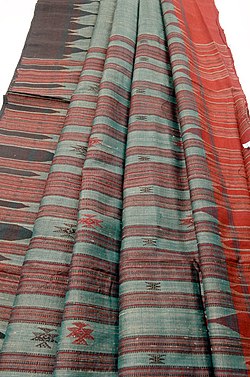Habaspuri sari
Habaspuri (Odia pronunciation: [habɔsɔpuɾi]) is a cotton-based traditional handloom textiles of Odisha, India. Habaspuri sari is a major product of this textile. The Kondha weavers of Chicheguda, Kalahandi district, Odisha are originally attributed for weaving of the Habaspuri fabric.[1] For its uniqueness in weaving, design and production, it has been identified as one of the 14 Geographical Indications of Odisha.[2][3] The textile has traditional patterns of the region like kumbha (temple), fish and flowers.
Etymology[edit | edit source]
Habaspuri handloom is named after the village of Habaspur in Kalahandi district where it was originally woven during 19 CE.[1]
Chicheguda[edit | edit source]
Around 30 weaver families in the village of Chicheguda village have working on reviving the Habaspuri handloom.[1]
Production and sales[edit | edit source]
The Habaspuri saris and other textile products produced by the individual weavers and groups are marketed and sold by the Handlooms, Textiles and Handlooms Department of the Government of Odisha in the government-run stores.[4]
References[edit | edit source]
- ↑ 1.0 1.1 1.2 Kar, Uma Shankar. "Habaspuri weavers seek marketing facilities: The painstaking efforts and creativity of Chicheguda weavers make every Habaspuri saree produced here a special piece. Mostly done in cotton, traditional designs of Kandha". The Indian Express. Retrieved 30 January 2016.
- ↑ "STATE WISE REGISTRATION DETAILS OF G.I APPLICATIONS 2012 – 2013" (PDF). Ipindia.nic.in. Department of Industrial Policy and Promotion: Ministry of Commerce and Industry. Archived from the original (PDF) on 25 June 2016. Retrieved 30 January 2016.
- ↑ Raju, Chaudhary, K.D, Seema (April 2013). "Geographical Indications in Odisha : A Leading Destination of Traditional Handlooms" (PDF). Odisha Review. Retrieved 30 January 2016.
{{cite journal}}: CS1 maint: multiple names: authors list (link) - ↑ "Important Handloom Centres". Important Handloom Centres. Handlooms, Textiles and Handlooms Department, Government of Odisha. Retrieved 30 January 2016.

